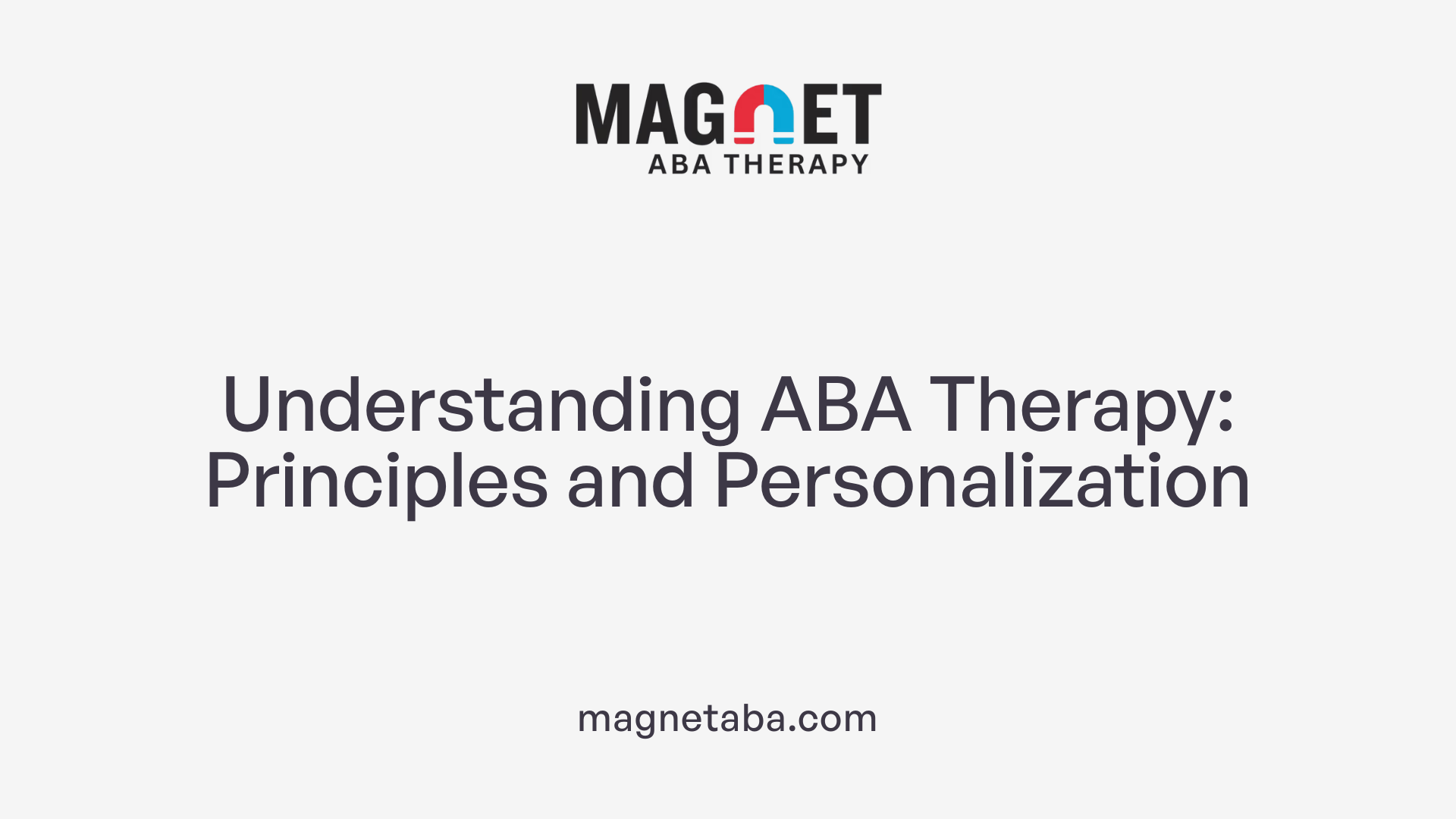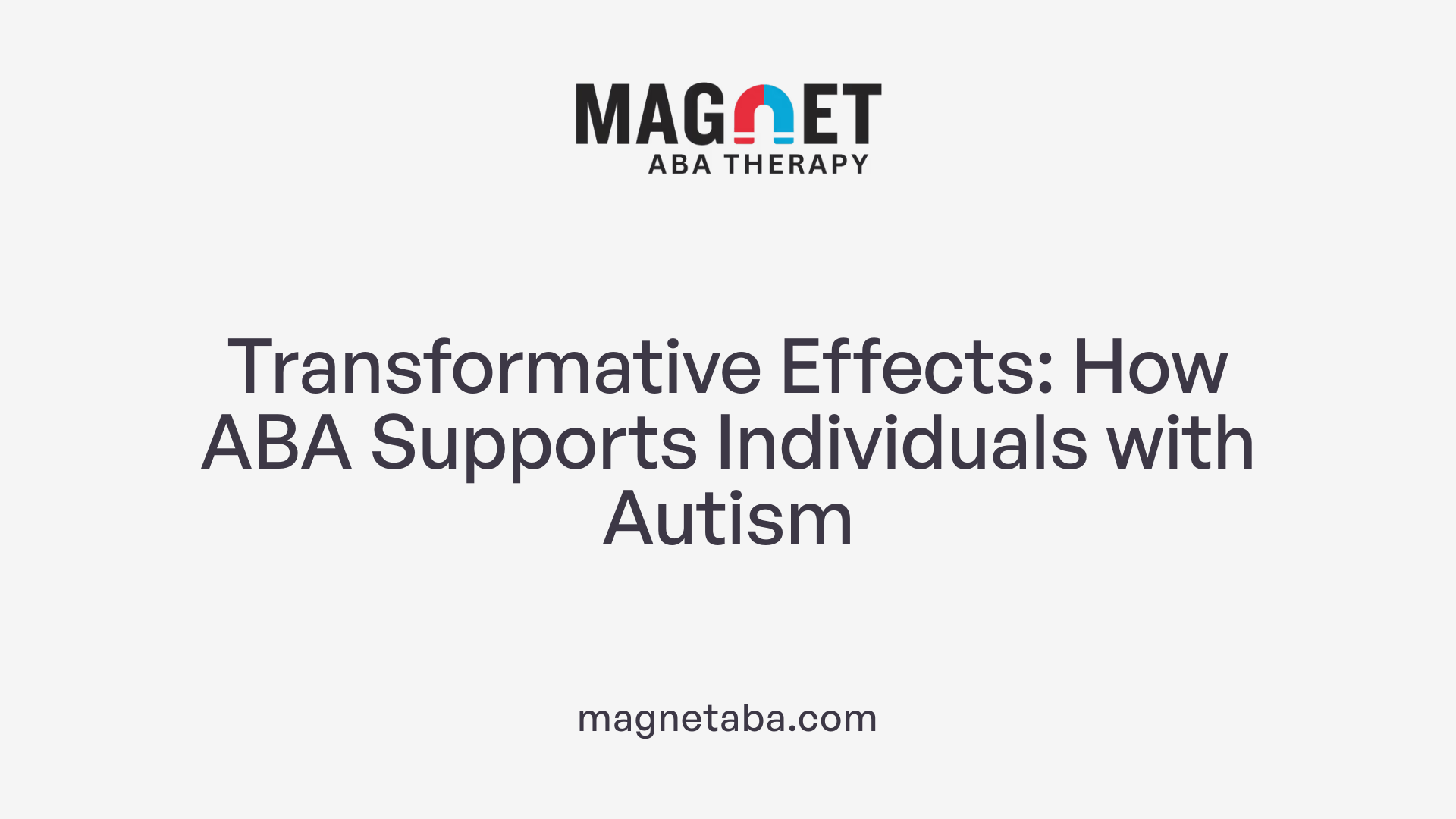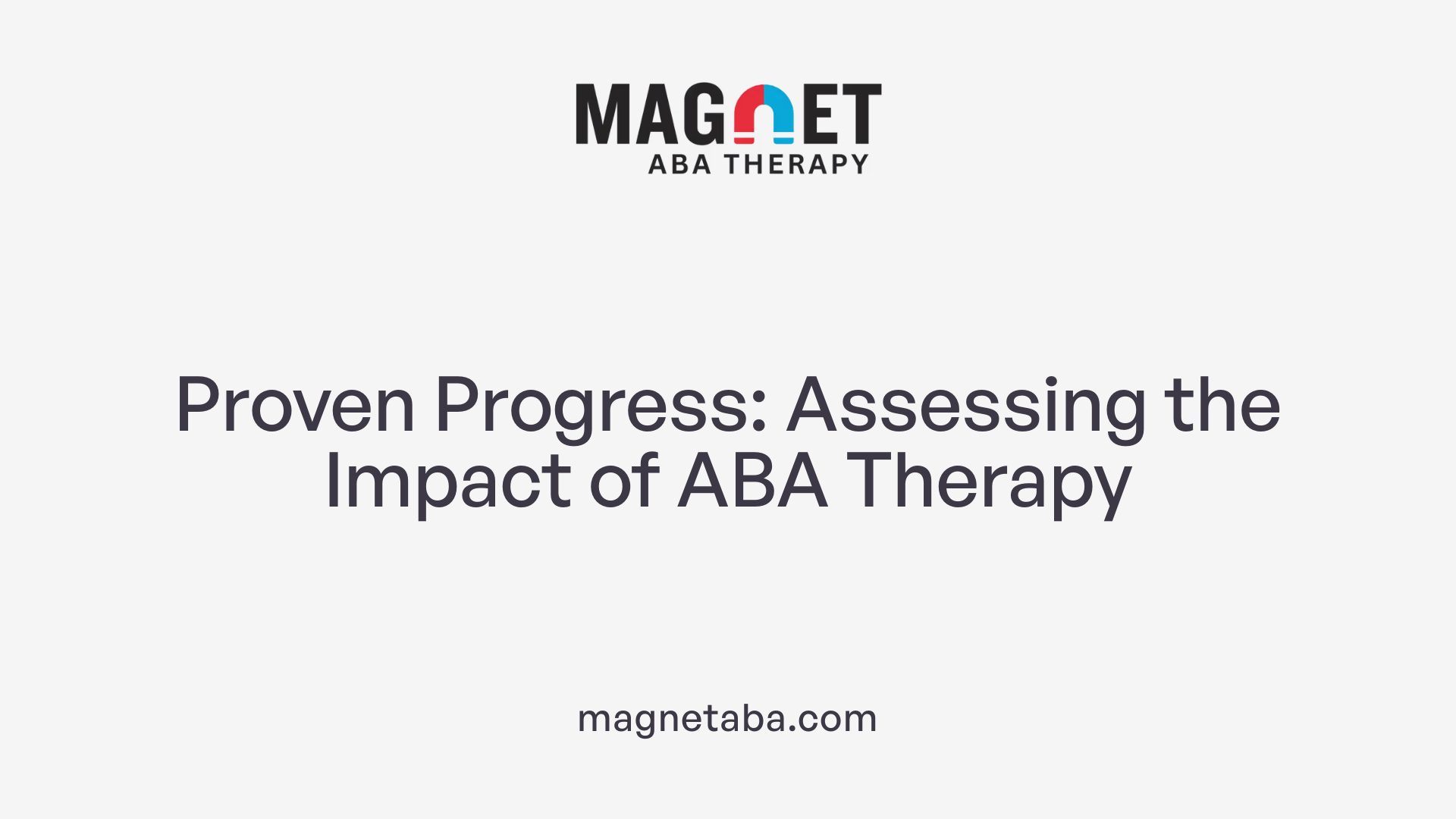Understanding the Behavioral Therapy Landscape
Behavioral therapies encompass a range of approaches designed to modify behavior through various techniques grounded in psychological science. Among these, Applied Behavior Analysis (ABA) stands out, particularly in its application to autism spectrum disorder and other developmental challenges. This article explores how ABA differs from other behavioral therapies, delving into its origins, methodologies, applications, and the unique benefits it offers compared to approaches like Cognitive Behavioral Therapy (CBT).
What is Applied Behavior Analysis (ABA) Therapy?

Definition of ABA therapy
Applied Behavior Analysis (ABA) therapy is a science-based approach aimed at improving specific behaviors, especially in individuals with autism spectrum disorder (ASD). It involves carefully analyzing behavior patterns and applying evidence-based strategies to teach new skills, such as communication, social interaction, self-care, and academics.
Scientific basis and principles
ABA is grounded in the principles of behaviorism, derived from the work of pioneers like Dr. John B. Watson and B.F. Skinner. It relies on learning theory, where behaviors are shaped by environmental consequences. Through conditioning, behavior analysts use techniques like positive reinforcement to encourage helpful behaviors while reducing harmful ones. The focus is on observable and measurable behavior changes.
Individualization of ABA programs
Each ABA program is tailored to the individual's unique needs, abilities, and goals. Board Certified Behavior Analysts (BCBAs) design personalized treatment plans, continually monitoring progress through data collection and adjusting interventions accordingly. This ensures that learning is relevant, effective, and meaningful to the client's everyday life.
Role of professionals in ABA delivery
Qualified ABA providers, particularly BCBAs, play a critical role in delivering therapy. They oversee interventions, train caregivers, and collaborate with families and schools to promote generalization of skills across different environments. Ethical guidelines and certifications ensure that ABA practices are respectful, safe, and evidence-based.
Intensity and duration of ABA therapy
ABA therapy typically begins between ages 2 and 6 and often involves intensive intervention, usually ranging from 20 to 40 hours per week. Therapy may continue for several years to achieve significant, lasting improvements, focusing on skill acquisition and behavior management.
Emphasis on positive reinforcement
Modern ABA stresses positive reinforcement over punishment, highlighting respectful and encouraging strategies that build independence. This shift promotes a supportive environment where individuals feel motivated to learn new skills and safely navigate their daily lives.
Historical Origins and Evolution of ABA Therapy

How did behaviorism contribute to the foundation of ABA therapy?
ABA therapy is rooted in behaviorism, a psychological approach established by Dr. John B. Watson and further developed by B.F. Skinner through operant conditioning. This framework asserts that behavior is shaped by environmental factors and can be modified using conditioning techniques, laying the scientific groundwork for ABA's methods.
Who pioneered the use of ABA therapy for autism?
During the 1960s and 1970s, Dr. O. Ivar Lovaas adapted ABA techniques to teach language and other essential skills to children with autism. His development of early intensive behavioral intervention (EIBI) marked a transformative milestone, demonstrating that structured behavioral teaching could enhance outcomes for autistic children.
How has ABA therapy evolved ethically over time?
Historically, ABA sometimes involved aversive techniques such as punishment to modify behavior, practices now broadly condemned. Modern ABA strongly emphasizes positive reinforcement and respects individual differences, focusing on ethical, individualized interventions that promote dignity and autonomy.
What recognition does ABA therapy have from health authorities?
ABA is recognized as an evidence-based, best-practice therapy by prominent health organizations, including the U.S. Surgeon General and the American Psychological Association. This formal acknowledgment affirms ABA's scientific validity and effectiveness in treating autism spectrum disorder and related conditions.
What ethical advancements define current ABA practice?
Contemporary ABA prioritizes respectful and individualized care overseen by certified professionals like Board Certified Behavior Analysts (BCBAs). The field adheres to rigorous ethical guidelines set by authorities such as the Behavior Analyst Certification Board (BACB), ensuring interventions are both effective and compassionate.
Core Techniques and Methodologies in ABA Therapy

What are the common techniques used in ABA therapy?
ABA therapy uses a variety of practical and evidence-based techniques to promote positive behavior change and skill acquisition.
Positive Reinforcement is central to ABA, where rewarding desired behaviors increases the likelihood that those behaviors will continue. This approach avoids punishment and focuses on encouraging helpful behaviors.
Discrete Trial Training (DTT) breaks down skills into small, manageable parts that are taught step-by-step in a structured manner. Each trial includes a clear instruction, a response from the individual, and a consequence, often reinforcement.
Modeling and Prompting involve demonstrating a behavior (modeling) or providing cues or assistance (prompting) to help the individual learn new skills. Prompting is gradually reduced or faded to encourage independent performance.
Behavior Chaining teaches complex activities by breaking them into smaller, sequential steps. Each step is learned and linked together, enabling the individual to complete multi-step tasks successfully.
Extinction and Redirection help decrease unwanted behaviors. Extinction involves withholding reinforcement that previously maintained a behavior, leading to its reduction. Redirection shifts the individual's focus from a challenging behavior to a more appropriate one.
Visual Supports and Behavior Contracts provide additional structure, using visual cues or written agreements to clarify expectations and reinforce consistent behavior. These tools are tailored to individual needs and enhance understanding and engagement.
Together, these techniques provide a flexible and comprehensive toolkit that ABA therapists use to create personalized, respectful, and effective intervention plans aimed at improving communication, social skills, self-care, and more.
How ABA Therapy Benefits Individuals with Autism

Skill development areas targeted by ABA
ABA therapy focuses on teaching a range of crucial skills that help individuals with autism navigate daily life more effectively. These include communication, social skills, self-care, play, leisure, and motor abilities. By improving these areas, ABA helps individuals participate more fully in various settings and activities.
Use of individualized evidence-based strategies
Each ABA program is tailored to an individual's unique needs. Board Certified Behavior Analysts (BCBAs) develop personalized plans based on careful assessment and ongoing data collection. This evidence-based and data-driven approach ensures that interventions are effective and relevant to the person’s life.
Positive behavioral supports
Modern ABA emphasizes positive reinforcement to increase helpful behaviors while reducing challenging ones. By focusing on rewarding desired actions rather than punishment, ABA creates a respectful and supportive learning environment that encourages motivation and engagement.
Early intensive behavioral intervention outcomes
Starting intensive ABA therapy early, often between ages 2 and 6, can result in significant developmental improvements. Early Intensive Behavioral Intervention (EIBI) pioneered by Dr. O. Ivar Lovaas has shown that such early work can boost language skills and social functioning, allowing some children to transition into mainstream educational settings.
Improvement in quality of life and independence
The ultimate goal of ABA is to enable individuals with autism to lead safer, more fulfilling, and independent lives. By enhancing communication and daily living skills, ABA fosters greater autonomy and social inclusion, which contributes to overall improved quality of life.
Measuring the Effectiveness of ABA Therapy

How is the effectiveness of ABA therapy measured?
The effectiveness of ABA (Applied Behavior Analysis) therapy is assessed through meticulous and systematic data collection. Behavior analysts track specific targeted behaviors across sessions, allowing them to monitor progress precisely and tailor interventions accordingly. This ongoing measurement ensures that the therapy remains responsive to the individual's unique needs.
Systematic Data Collection and Progress Monitoring
Behavior analysts use continuous data recording methods during therapy sessions to track skills such as communication, social interaction, self-care, and motor abilities. These data allow for objective analysis of behavioral changes, enabling timely modifications to the treatment plan.
Use of Standardized Assessments
Alongside session data, standardized tests and pre- and post-intervention assessments provide quantitative insight into improvements. These assessments evaluate areas such as IQ, expressive language, and adaptive functioning, contributing to a comprehensive understanding of therapy outcomes.
Observed Improvements in IQ, Communication, and Social Skills
Research shows significant gains in intellectual capacity and communication skills in children undergoing ABA therapy. Improvements in social interaction and expressive language have been documented with moderate to strong effect sizes. Although progress in daily living skills may be smaller, the overall impact on core developmental domains highlights ABA’s beneficial role.
Long-term Tracking and Plan Adjustments
ABA programs typically involve long-term treatment plans, often lasting several years. Continuous progress monitoring allows Board Certified Behavior Analysts (BCBAs) to adjust goals and strategies, ensuring interventions stay effective and relevant to the client’s evolving abilities.
Meta-Analytic Evidence Supporting ABA Efficacy
Numerous meta-analyses affirm the efficacy of ABA therapy through aggregated data, confirming positive behavioral changes and skill acquisition in autistic children. These studies provide a robust evidence base for the use of ABA as a best-practice intervention.
| Measurement Approach | Description | Purpose |
|---|---|---|
| Systematic Data Collection | Ongoing recording of targeted behaviors during sessions | Monitor progress and modify treatment plans |
| Standardized Assessments | Formal tests before and after intervention | Quantify improvements in IQ and skills |
| Observational Reports | Qualitative and quantitative behavior observations | Assess real-life application of learned skills |
| Long-term Monitoring | Continuous evaluation over months or years | Adapt interventions to changing needs |
| Meta-Analytic Research | Analysis of multiple studies | Validate overall therapy effectiveness |
Professionals Providing ABA Therapy Services
Who provides ABA therapy services?
ABA therapy is delivered by a range of trained professionals who specialize in applied behavior analysis. The most recognized providers are Board Certified Behavior Analysts (BCBAs), who are responsible for developing personalized treatment plans and supervising the therapy process. Behavior therapists and other specialized practitioners also play crucial roles, working directly with clients to implement these interventions.
Role of Board Certified Behavior Analysts (BCBAs)
BCBAs design and oversee individualized ABA programs based on each client's needs. Their certification ensures they follow ethical guidelines and evidence-based practices, continually monitoring progress and making necessary adjustments to the treatment.
Behavior therapists and specialized practitioners
These professionals carry out therapy sessions, applying techniques that increase positive behaviors and teach vital skills such as communication, social interaction, and self-care. Many hold specialized training to support various developmental or behavioral challenges effectively.
Settings for ABA therapy delivery
ABA services are adaptable and provided across diverse environments including the home, schools, clinics, and community locations. This flexibility supports natural learning and family involvement, making therapy more effective and contextually appropriate.
Company and clinic involvement
Many therapy providers operate within established clinics or companies, which maintain high standards through accreditation and adherence to evidence-backed methodologies. Organizations like ABA Insight and Cortica exemplify such structured service delivery.
Importance of professional training and accreditation
Ongoing training and certification ensure professionals stay updated on best practices, ethical standards, and the latest research developments in ABA. This commitment to quality guarantees that individuals receive respectful, data-driven interventions tailored specifically to their unique needs.
Distinctive Features of ABA Compared to Other Behavior Therapies
Focus on Observable, Measurable Behaviors
Applied Behavior Analysis (ABA) is distinguished by its strict focus on behaviors that can be clearly observed and quantified. Unlike some therapies that delve into thoughts or emotions directly, ABA targets actions and reactions, making it possible to measure progress objectively. This focus ensures that interventions can be precisely tailored and outcomes accurately tracked over time.
Data-Driven Individualized Interventions
ABA therapy relies heavily on collecting and analyzing data for each individual. Behavior analysts use this information to create personalized treatment plans that address the specific needs and goals of their clients. This approach allows for adjustments based on the individual's progress, ensuring interventions remain effective and relevant.
Seven Dimensions Ensuring Generalization and Relevance
The methodology of ABA incorporates seven dimensions, including generality, effectiveness, and technological precision, among others. These dimensions guarantee that learned skills transfer across different settings and situations, that interventions produce meaningful improvements, and that the techniques used are replicable and transparent. Ultimately, this framework keeps the therapy client-centered and scientifically grounded.
Ethical Standards and Scientific Foundation
ABA practices adhere to rigorous ethical guidelines, closely monitored by professional bodies such as the Behavior Analyst Certification Board (BACB). Modern ABA emphasizes positive reinforcement over punishments and focuses on respectful, individualized care. Its foundation in behavioral science and continuous research assures that interventions are not only ethical but also evidence-based.
Wide Application Across Developmental Disorders
Though well-known for its use with autism spectrum disorder (ASD), ABA’s principles and techniques apply broadly. It supports individuals with conditions including ADHD, OCD, ODD, PTSD, and traumatic brain injury. This versatility highlights ABA's adaptability and comprehensive impact across various developmental and behavioral challenges.
Comparing ABA and Cognitive Behavioral Therapy (CBT)
Foundational principles of ABA vs CBT
ABA (Applied Behavior Analysis) is grounded in behaviorism, focusing on observable and measurable behaviors shaped by environmental influences. It operates on the principle that behavior can be modified through conditioning and reinforcement. In contrast, CBT (Cognitive Behavioral Therapy) blends behavioral principles with cognitive theory, addressing not only behaviors but also underlying thoughts and feelings to manage emotions and promote mental health.
ABA’s focus on behavior and environment vs CBT’s cognitive restructuring
ABA targets increasing helpful behaviors and decreasing harmful ones by analyzing and modifying the environmental consequences of behavior. It concentrates on skill acquisition, such as communication, social interaction, and self-care. CBT emphasizes cognitive restructuring—helping individuals identify and transform negative thought patterns to improve emotional regulation and coping strategies. Techniques include guided discovery, exposure therapy, and relaxation practices.
Appropriate age and skill levels for each therapy
ABA is most effective for younger children, particularly between ages 2 and 6, including those with severe deficits or who are nonverbal. It often involves intensive interventions lasting years. CBT is generally suited for children aged 7 and above, who possess stronger language abilities and abstract thinking skills necessary for engaging in talk therapy and cognitive exercises.
Types of issues addressed by each
ABA primarily addresses challenges related to autism spectrum disorder, such as improving communication, reducing repetitive behaviors, and enhancing social skills. It is also used for ADHD, OCD, ODD, PTSD, panic disorder, and traumatic brain injury by encouraging positive behaviors and coping mechanisms. CBT mainly targets emotional and mental health issues like anxiety, depression, and oppositional defiant disorder, often co-occurring with autism.
Integration for comprehensive treatment
Combining ABA and CBT can offer a holistic approach. ABA focuses on behavioral management and skill-building, while CBT addresses cognitive and emotional factors. This integration supports simultaneously tackling behavioral challenges and mental health needs, leading to more comprehensive and personalized interventions for children with autism and other developmental or psychological conditions.
Criticisms and Evolving Perspectives on ABA Therapy
What were the historical concerns regarding ABA therapy?
Early applications of ABA involved the use of punishment and aversive techniques to reduce unwanted behaviors. These methods, now considered unethical, caused significant concern among families and advocates for autistic individuals. Such practices contributed to a perception of ABA as harsh and overly controlling.
How has ABA therapy changed in its approach today?
Modern ABA prioritizes positive reinforcement over punishment. Therapy is designed with an emphasis on dignity, respect, and individualized treatment. This shift ensures that interventions support each person’s unique needs and promote a respectful and supportive environment.
Why is there criticism about ABA focusing on normalization?
Some critics argue that ABA has historically aimed to make autistic individuals conform to neurotypical standards, potentially suppressing natural autistic traits. This has raised concerns about disregarding neurodiversity and the value of different ways of experiencing the world.
How is ABA evolving to address concerns about independence and individuality?
Contemporary ABA advocates focus on promoting independence, self-advocacy, and quality of life. Therapists integrate neurodiversity-affirming principles, tailoring programs to enhance personal strengths and support meaningful goals rather than enforcing conformity.
This evolution reflects a broader commitment within the ABA community to ethical, positive, and person-centered approaches that respect the individuality of those they serve.
ABA Therapy’s Broader Applications Beyond Autism
How is ABA Therapy Used with Other Disorders?
ABA therapy, originally developed for autism spectrum disorder, has proven effective for a range of other conditions. It is commonly adapted for children with Attention-Deficit/Hyperactivity Disorder (ADHD), Obsessive-Compulsive Disorder (OCD), Oppositional Defiant Disorder (ODD), post-traumatic stress disorder (PTSD), panic disorder, and traumatic brain injury (TBI).
What Behavioral Strategies Are Adapted for Different Disorders?
ABA uses various behavioral strategies tailored to each disorder. For ADHD, token economies are often implemented to encourage positive behaviors and social skills, although ABA does not directly treat core ADHD symptoms. In OCD, ABA helps reduce compulsive behaviors by teaching healthier responses to anxiety triggers, often alongside psychotherapy. For ODD, reinforcement techniques focus on promoting positive interactions with authority figures instead of punishment. PTSD and panic disorder interventions involve gentle exposure to triggers combined with developing coping strategies. Children with TBI benefit from behavior modification and relearning social skills to improve functioning.
How Does ABA Complement Mental Health Therapies?
ABA therapy often works in conjunction with other mental health treatments. For instance, in OCD and anxiety-related disorders, ABA is combined with cognitive and talk therapies to address both behavioral symptoms and underlying emotional factors. This complementary approach helps children build comprehensive coping skills and emotional resilience.
What Is the Focus of ABA Across These Conditions?
Across these diverse applications, ABA concentrates on reinforcing positive behaviors, reducing harmful or disruptive actions, and teaching practical coping skills. The therapy is highly individualized, respecting the unique needs of each child and promoting safer, more fulfilling lives through structured behavioral interventions.
Typical ABA Therapy Implementation and Settings
Starting Age and Therapy Intensity
ABA therapy typically begins between ages 2 and 6, with many programs starting before age 3, especially for children with significant communication or developmental challenges. Early intensive behavioral intervention (EIBI) often involves 20 to 40 hours of therapy per week. This intensity helps maximize skill acquisition and behavioral improvements during critical developmental periods.
Settings Including Home, School, Community, and Clinics
ABA sessions are highly flexible and can be conducted in various settings to promote generalization of skills. Common environments include the child's home, schools, community locations, and specialized clinics. Delivering therapy across multiple settings helps children apply learned skills in real-life contexts, improving their daily functioning.
Customization According to Individual Needs
Each ABA therapy plan is personalized by Board Certified Behavior Analysts (BCBAs) to address the unique strengths, challenges, and goals of the individual. This customization ensures that interventions focus on relevant skills such as communication, social interactions, self-care, play, and safety tailored to the child’s developmental level and interests.
Family Involvement and Naturalistic Learning
Family members are often involved in therapy to reinforce positive behaviors outside therapy sessions. Naturalistic learning approaches encourage skill development during typical daily routines, enhancing motivation and promoting seamless generalization of new behaviors to everyday life.
Duration and Goal Adjustment Over Time
The duration of ABA therapy varies but often spans up to three years, depending on individual progress and goals. Goals and interventions are regularly adjusted based on ongoing data collection and assessment to ensure the therapy remains effective and aligned with the child's evolving needs.
Future Directions and Integration with Other Therapies
Combining ABA with CBT and other approaches
The future of Applied Behavior Analysis (ABA) therapy increasingly involves integration with Cognitive Behavioral Therapy (CBT) and additional therapeutic methods. While ABA targets observable behaviors and skill development, CBT addresses underlying cognitive and emotional processes. Combining these therapies allows for a more comprehensive intervention, simultaneously managing behavioral challenges and emotional regulation deficits.
Holistic addressing of behavioral and cognitive challenges
Integrating ABA with cognitive and emotional therapies creates a holistic model that supports children with autism and related conditions more effectively. Such programs can improve not only communication and social skills but also help manage anxiety, depression, and emotional resilience. This multifaceted approach respects the complexity of neurodevelopmental and mental health needs, tailoring intervention to individual profiles.
Research trends and evolving evidence bases
Current research trends emphasize personalized, evidence-based interdisciplinary treatments. Studies support ABA’s efficacy as a foundation, with growing evidence highlighting the benefits of adding CBT for emotional and behavioral comorbidities. These combined models show promise in improving long-term outcomes, suggesting a shift towards multidisciplinary care frameworks.
Potential for personalized multidisciplinary programs
The future envisions personalized multidisciplinary programs where Board Certified Behavior Analysts (BCBAs), psychologists, speech therapists, and other professionals collaborate. These teams design individualized treatment plans incorporating behavioral, cognitive, social, and emotional strategies. This collaboration ensures interventions remain ethical, respectful, and responsive to the evolving needs of each child, promoting independence and quality of life.
Bridging Differences in Behavioral Therapies
Applied Behavior Analysis distinguishes itself through its rigorous scientific foundation, individualized focus on observable behaviors, and evidence-based methodology emphasizing positive reinforcement and skill development. While other behavior therapies, such as Cognitive Behavioral Therapy, address cognitive and emotional aspects alongside behavior, ABA primarily targets early skill acquisition and behavioral challenges, especially in individuals with autism and related disorders. The therapies serve complementary roles, with ABA’s data-driven, ethical, and adaptable practices making it a cornerstone in developmental interventions. Understanding their differences and potential integrations allows families and practitioners to tailor effective, respectful, and comprehensive behavioral support for diverse needs.
References
- ABA and other therapies
- ABA Therapy vs CBT for Autism: Which is Better?
- Is ABA Therapy Only for Autism?
- Applied Behavior Analysis (ABA)
- The Top 10 Reasons Children With Autism Deserve ABA
- Applied Behavior Analysis (ABA)
- Patient Outcomes After Applied Behavior Analysis for ...
- Efficacy of Interventions Based on Applied Behavior ...











